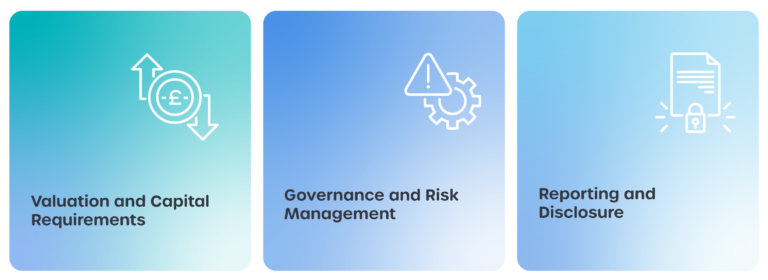The extensive reporting requirements required by Solvency II are vital for regulators, stakeholders, and policyholders to assess an insurer’s financial stability and risk profile. Insurers must use a market-consistent approach to value their assets and liabilities. This includes regular reporting on the valuation of investments and the calculation of technical provisions.
For UK insurance firms, the PRA’s National Specific Templates (NSTs) are a set of regulatory reporting templates that supplement the Solvency II annual and quarterly reporting requirements. They collect additional information that is specific to the UK market and supervisory approach. This can include data on business models, risk management, and governance. The purpose of these is to help the PRA to assess the financial strength and risk profile of UK insurance firms and, consequently, tailor its supervision accordingly.
Solvency and Financial Condition Report (SFCR)
This report needs to be prepared annually and provides a comprehensive overview of the insurer’s business, governance, risk profile, and financial position. It should include information on the company’s risk management framework, capital adequacy, and solvency ratios. Summaries of the SFCR will be provided to policyholders and the public, this will give insights into an insurer’s financial health and risk management practices.
Regular Supervisory Reporting
These are a series of regular quantitative reports that insurers must submit to their supervisory authorities. These reports provide detailed data on an insurer’s assets, liabilities, and capital adequacy. The frequency of these reports varies, with some submitted quarterly, semi-annually, or annually.
Own Risk and Solvency Assessment
This assessment is for insurers to establish their overall solvency needs. It will cover how an insurer manages and mitigates risks, provides insights into their risk appetite, and demonstrates their ability to meet their obligations to policyholders. This report is a critical part of Solvency II’s risk management framework.
Quantitative Reporting Templates
These are a set of standardised templates that insurers can use to report quantitative data. They cover a wide range of areas, including technical provisions, own funds, and solvency capital requirements. Insurers must complete and submit these templates on a regular basis.
Stress and Scenario Testing
Insurers are expected to conduct stress and scenario tests to assess the impact of adverse situations on their solvency position. The results of these tests must be reported to supervisory authorities.
The Tri-Partite Template and Solvency II
The Tri-Partite Template (TPT) is an industry developed template that specifically pertains to asset managers and other service providers that support insurers. It’s designed to facilitate information flow between insurers, asset managers, and custodians.
The TPT takes the form of a standardised reporting template that asset managers and custodians use to provide insurers with information about the assets they manage on behalf of insurance companies. It will typically include detailed data on the assets and investments managed by the asset manager for the insurer. This data may cover a wide range of asset classes, such as equities, fixed income securities, alternative investments, and more. The goal is to capture information regarding the nature, quality, and risk profile of the assets held by insurers.
The frequency of TPT reports is usually determined by regulatory authorities or by the contractual agreements between insurers and asset managers. Depending on the agreement or authority, reports may be submitted quarterly or annually, and should reflect the assets under management during the specified reporting period.



